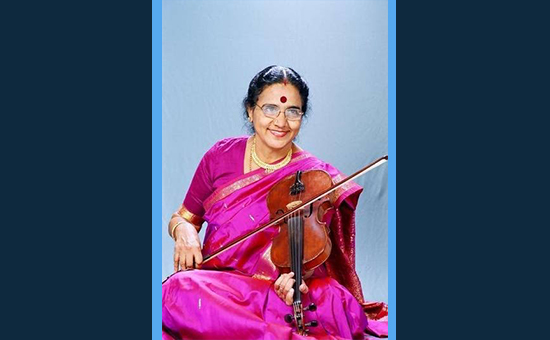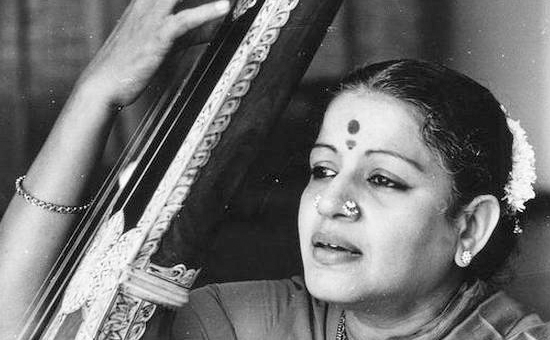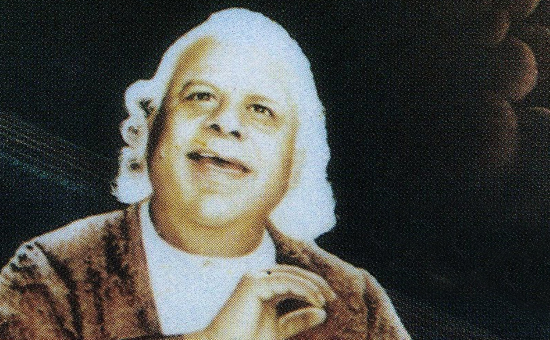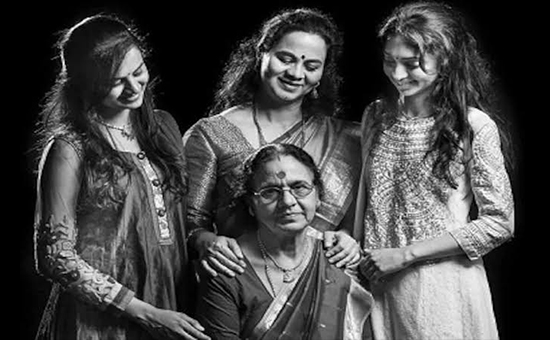- On International Women’s Day we present a conversation with noted violinist Dr N Rajam, her daughter and granddaughters.
The very first thing which comes to your mind reading the title of this story would be non-other than the legendary Violinist Padma Bhushan Dr N Rajamji with her daughter Sangita Shankar and granddaughters Ragini and Nandini Shankar, all four mastering a violin to create the magic with the bow, displaying a unique interplay of different sounds that each of them creates in their 3 Generation Concerts...Dr Priyaankaa Mathur talks to these highly intellectual women about the taleem and musicality bestowed upon them under the strict discipline of Gurushishya Parampara, which enabled
them not only to propagate the traditional repertoire, while also presenting it
with a zing to the future generations.
She is known for her inimitable violin playing technique, while her instrument is titled the 'Singing Violin' of India. Dr N Rajam's journey into the world of music began with her initial training in Carnatic Music from her illustrious father Vidwan A Nayaran Ayer.
In this conversations Dr Rajam tells it all - From learning Hindustani classical music to mastering the art at the lotus feet of the legendary exponent of Gwalior Gharana Pandit Omkarnath Thakurji, who developed her sensibilities towards finding a suitable technique to play the Gayaki ang most naturally on the violin.

Reminiscing
about her childhood days she says, “As part of our family tradition, when a child turned three years old a violin was handed over to him or her and rigorous training is started from that day. My father was a strict disciplinarian although he would find ways and means to make a child practice sometimes giving even some incentives. Looking at my ability to pick fast he chose to skip the early lessons and taught me the 'Varnam', which is normally taught after 5-6 months of finger training exercises, following which my rigorous training continued for the next 5 years i.e. till the age of 9.”
Rajam
eventually turned into a child prodigy. While she attained proficiency on the
instrument, she qualified for the All India Radio Auditions, and started
broadcasting. By the time she was 13 she could reciprocate intricacies of vocal
music on her instrument. She was fortunate and blessed to accompany Bharat
Ratna M S Subhalaxmiji for a series of concerts all over India.

Eventually,
she joined Banaras Hindu University to learn Hindustani classical music since
her father wanted at least one of his children to take up Hindustani Classical
music. She was introduced to the melodious renditions of Pandit Omkarnath by a
friend who played to her his 78 RPM records. She was spellbound as his music
captivated her to such an extent that she decided to learn the Hindustani
classical music system from non-other than him.
Talking about her training under the Maestro she says, “It happened that I learnt Hindustani ragas from a teacher who came to teach me for my BHU examination, who was a disciple of Panditji. Guruji was the founder and principal of the music college in Banaras and so I met him there. He asked me to play something on the violin and I tried to reproduce the pieces he sang in the records. Eventually, he became very impressed and asked me to give a presentation in the music college and sang with me saying “Here is an example of an Eklavya.” Later he accepted me as his disciple and began my taleem under him.
My fingers and violin technique were there, but what was missing was the spirit of Hindustani music. “Guruji taught me modulation in the volume 'Kaku Bheda' which helps in the very expression and 'Bhav Abhivyakti' in the raga rendition and the intricacies in the bandish 'Badhawa ladli' in Raga Todi along with many more.”
 Pranams to Guruji, Pandit Omkarnath.
Pranams to Guruji, Pandit Omkarnath.
She adds, “While I was learning with him I realised that the violin technique I had was not adequate for some of the subtleties and nuances of Hindustani classical music like the taans and especially of guruji's which were so strong. For that, I needed to have a more sophisticated technique. This need guided me to research for over 15 years.
As a result I came out with a highly sophisticated left hand and right-hand technique to play the violin that reproduced the intricacies of any vocal form of Hindustani music be it Khayal, Dhrupad, Tarana, Thumri, Bhajan. Embellished with 'Meends', 'Gamaka' and 'Kands', the Hindustani music is never plain and includes subtle nuances of the 'Shrutis'.
When I played this new technique for the first time, it was very well received while some people were even astonished to know that all this was possible to play on the violin."
So what made her violin sound like a singing violin?
She says, “I played the violin in the vocal style from the very beginning, since in Carnatic music there is no style for the instruments, so whatever is played is the vocal style be it a Violin, Veena or Flute. After listening to other violinists I found they were following the 'Gatkari style' i.e. the style played on the plucked instruments like Sitar and Sarod. I thought that the violin being a bowed instrument a continuity of tone can be maintained on it to suit the vocal style the most.”
It was
teaching which gave her peace and happiness. Thus, she served Banaras Hindu
University, as a Professor Dean of the Department of Music, for over 40 years.
She taught at Dr Gangubai Hangal Gurukul in Hubli and is currently working with
another Gurukul in Pune, as sharing knowledge is an integral part of her family
tradition.
Her daughter Sangita Shanker is not only an ace Indian classical Violinist, but also a composer and an educationist, Sangitaji talks about the lineage which runs in the family, “If we look at our family lineage my daughters are the 8th generation of traditional musicians, wherein the earlier musicians were more inclined towards the Carnatic style, while from my mother onwards the three generations follow the Hindustani classical music, as represented by the Gwalior Gharana."
Sangita ji fulfils her vision of providing comprehensive training in music at Mumbai’s Whistling Woods Films Institute where she is Head of the Department of Music. She says," Looking at the youngsters of today, who think composing music is an easy job, I believe for even creating any kind of music, basic fundamental knowledge is required. That's another way to serve the field of music by educating aspiring music composers.
Whistling Woods provides comprehensive training of Indian Classical, Semi-classical and Folk Music genres, Compose, Record, Mix, Edit, Produce, western music orchestrations, technology and arrangements for film scores in a 3-year degree course in music production and composing. I too equipped myself along with my daughter's with these trainings, which helps us today to produce our music substantially.”
Dr Rajam’s granddaughter Ragini Shanker talks about keeping the right balance says, “My sister Nandini and I were put to the traditional format of Hindustani classical training at the age of 3, but at the same time education was an integral part of our family which we had to follow. Since I was technically very sound and good in design I chose mechanical engineering, while Nandini did her Chartered Accountancy. Nevertheless early morning 5 am regular practice was always a strict routine for us, which we always followed before going to college. Apart from that, Grandmother made us complete our masters in Hindustani Classical music so that we have a complete know-how of the theory of music side by side.”
 Dr Rajam with daughter and granddaughters.
Dr Rajam with daughter and granddaughters.
Ragini adds, “Nandini and I gave our first duet performance when she was 8 and I was 11 years old. By the time I reached the age of 13, I had a realisation that 'Sadhana' is like an inner worship and it is a serious thing to do. That's when I became self-motivated and decided to take music as a profession. Our grandmother believes that the stage should be regarded as a sacred space and one should not enter unless one is perfectly ready. When she found we were ready she allowed us to take up music full time and since then there was no looking back.”
Elaborating on Guru Shishya Parampara she says, “We are immersed in the musical environment all day be it my grandmother's practice or her students. We are exposed to all of it, apart from our riyaz. It is not only the direct learning but also we discuss music, as whom to listen and what unique features one needs to notice in a rendition, while she guides us. When we sit in front of her we try to absorb everything she plays and reproduce it, which is very natural.”
Speaking about the basic technique of the instrument Nandini says, “Initially, both Ragini and I were initiated in taleem by our grandmother with small-sized lighter versions of the violins. When we turned 3 and within a year or so, we got the full-sized instruments. The basic technique of playing the violin is that it's played with the skin of the fingertips and for that reason, the nails always need to be cut and trimmed well in your left hand, so that the skin can hit the strings directly, while its strings are soft and don't cause much damage on the skin. We began with doing Kriti's of Carnatic music to bring fluency in the hands, then began our full-fledged training in Hindustani classical music. I remember the first raga being taught to us was Raga Malkauns, which musicality wise sounds a little tough, but from the playing technique on the violin it is quite manageable.”
She adds, “It was around 2010-2011 that we started performing 3 generation concerts, which always requires a lot of hard work to accompany our grandmother on stage. Some of the ragas like Darbari Kanhara, Miyan Malhar, Bhairavi, Bageshri Kanhara and some of the compositions of Pandit Omkarnath Thakurji's in Raga Nilambari and Tilang, which have a lot of depth, require a lot of practice and focus to get what she is playing, which we try to master them every time we sit on the stage.”
Nandini concludes by telling what qualities of her grandmother would she like to imbibe, "She has developed her style to an extent which is both deep at one point and playful with the Taal at the other, which sounds effortless to the listeners. Her dedication towards the art and the effort she had made to bring out this technique is very inspiring. I just wish to imbibe this quality of hers. Even at her age and stature she is looking at that one thing which can be played better.”
To read all articles by author
To see performance video
1. Dr N Rajam and family 4.49
minutes
2. Dr N Rajam and family at
their best 22.48 minutes